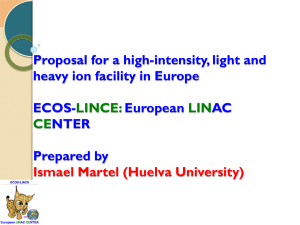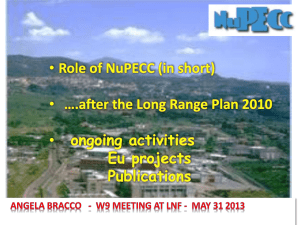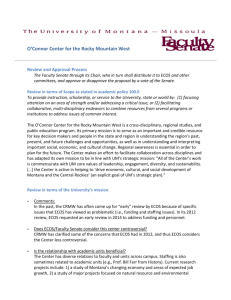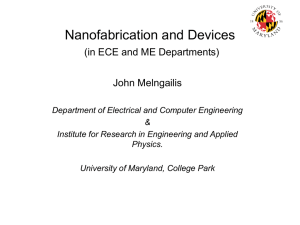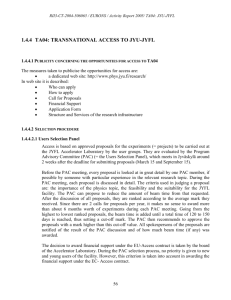ECOS - NuPECC
advertisement
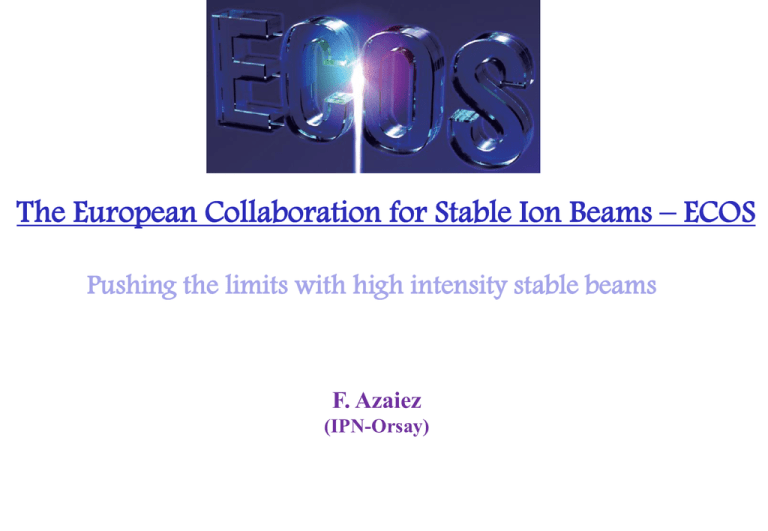
The European Collaboration for Stable Ion Beams – ECOS Pushing the limits with high intensity stable beams F. Azaiez (IPN-Orsay) ECOS ‘Working Group within NuPECC’ ECOS: European COllaboration for Stable (ion beams) Marie-Helene Moscatello / M. Levitowicz (GANIL) Annamaria Porcellato (Legnaro) Uli Ratzinger (GSI) Sigurd Hofmann (GSI) Rauno Julin (JYFL) Faical Azaiez (IPN-Orsay) Jacomo Deangelis (Legnaro) Rolf-Dietmar Herzberg (Liverpool) Task: Produce a document to NUPECC with: --The Science with high intensity stable ion beams, Beam intensity limitations and technical developments for various types of research lines! --Status and future developments of existing facilities --Recommendations NuPECC/ECOS web pages --The Science with high intensity stable ion beams, Beam intensity limitations and technical developments for various types of research lines! N=Z nuclei (in–beam spectroscopy and decay studies) : G. DeAngelis SHE search : S. Hofmann Super heavy nuclei (in-beam spectroscopy and decay studies) : R. D. Herzberg Neutron-deficient nuclei (in-beam spectroscopy and decay studies) : R. Julin Exotic shapes and decay modes in nuclei : F. Azaiez Neutron rich nuclei using DIC reactions : F. Azaiez & G. DeAngelis Nuclear astrophysics: S.V. Harissopulos --Status and future developments of existing facilities LEGNARO : A. Porcellato GANIL : M. H. Moscatello/M. Lewitovicz GSI : S. Hofmann&U. Ratzinger JYVASKYLA : R. Julin KVI : S. Brandenburg CATANIA: S. Gammino --Recommendations NuPECC web pages Recommendation (iii) The UNILAC upgrade will provide one order of magnitude greater beam intensities than today. This is a major improvement which will greatly enhance the program to search and study super heavy elements. The realisation of this up-grade is considered highly important and the committee lends it its full support. LINAG, the SPIRAL2 driver is another attractive possibility as it fully matches the specification of the needed high intensity stable ion beam facility, a significant amount of beam time is foreseen to be used for the production of high intensity light and medium mass stable ion beams This project is recommended as a first step to the desired facility as well as its future upgrade to heavier masses (LINAG2) It is an important proof of feasibility and test bunch for all technical issues related to very high intensity heavy ion beams. Recommendation (iv) It is clear that the use of the upgraded UNILAC and the very intense light and medium beams from LINAG is an attractive short-medium range perspective for the community from the point of view of the physics opportunities and also from the point of view of the possibilities of testing and improving instruments and methods. The long term goal for a new dedicated high intensity stable ions facility in Europe is considered to be one of the important issues to be discussed and considered in the next Long Range Plan of the nuclear physics community. In this context, the importance of an complementary low-energy-high-intensity stable-beam facility dedicated to Nuclear astrophysics studies needs also to be considered. Recommendation (v) In order to be ready for this new project it is also highly important that research and development on the various related keys issues such as target, spectrometers and ion sources, are initiated and organised at the European in synergy with future RNB projects: 1. Development of High current ion sources 2. Development of high power thin targets 3. Improvement of the ion-optical properties of the separator with respect to high transmission and reduced background. 3. Increase of the detector granularity and installation of an appropriate signal processing and data acquisition system. ECOS ‘ Network within ENSAR’ The objectives of ECOS: --Bring together and coordinate the expertise that is available in the European countries in order to achieve the research and developments activities needed in all aspects related to the production and use of high intensity heavy ion beams. --Optimize resources and manpower for the up-grade and development of various stable ions beam facilities in Europe in order to optimize their scientific output. From this point of view, NA02-ECOS has a direct link to the TNA delivering stable ion beams to the users community in Europe. These are GSI, GANIL, LNL/LNS, JYFL , ALTO and KVI Description of work Task 1 High power thin-target technology The maximum usable primary beam current with thin targets is among others determined by the long-term stability of the thin targets under irradiation. High beam intensities lead to a considerable heating of the targets, and, hence to thermal stress, possibly phase transitions, oxidation or reduction of the chemical compounds and diffusion into the target backing respectively. We propose to study these phenomena in detail and to compare for example the performance of thin actinide targets as function of the production method (painting, spray-painting, electrolysis, electro-deposition, evaporation and sputtering), the used chemical compounds (oxide, carbide, others) and backings/coatings respectively. The way is to bring together labs that use different techniques for target preparation and those that can test the target performance under “real” conditions. For this task ECOS will have the duty to organize the collaboration and exchange of expertise on the development of high power target technology Task 2 Synergies in Super Heavy Element Research The study of Super Heavy Elements (SHE) is one of today’s most challenging interdisciplinary research fields. It brings together nuclear physics, atomic physics, chemistry and theoretical physics. Over the last years researchers from the different disciplines have continued to strengthen exchange of ideas. The ECOS community proposes to use this Network in order to enhance synergies among the research groups on a European scale. For this task ECOS is aiming for bringing together the groups with research activities on SHE using high intensity ion beams for an exchange of new ideas and techniques related to the use of very high intensity stable beams. Task 3 Organisation of bi-annual ECOS Workshops In order to optimize resources, two workshops will be organised with parallel sessions dedicated to all aspects of the technical developments and research activities using stable ions beam facilities in Europe. The second workshop will be coupled to the NA town meeting Task 4 Coordination of stables Ion beam facilities in Europe This third task is aiming for coordination and organization of the network. Steering committee F. Azaiez (IN2P3) D. Ackermann (GSI) G. Deangelis (LNL) M. Lewitowicz (GANIL) A. Maj (Krakow-Warsaw) R. Julin ( JYFL) ECOS-NA 6 Beneficiaries 30 associate partners GANIL (France) IN2P3 (France) GSI-Darmstadt (Germany) INFN (Italy) University of Jyvaskyla (Finland) IFJ PAN Krakow - HIL UW Warsaw(Poland) NIPNE-Bucarest (Roumania) NCSR Demokritos (Greece) IN2P3 (France) Atomki- Bebrecen (Hungary) Department of Physics, University of Liverpool (UK) HIL UW warsaw (Poland) KVI –Groningen (Nederlands) SAFE –University of Oslo (Norway) CEA-Saclay (France) CEA-Bruyeres-le –Chatel (France) LMU Munich (Germany) TU Munich (Germany) IRMM Geel, (Belgium) INRNE-BAS, Sofia (Bulgaria) University of Sofia (Bulgaria) Lund University (Sweden) Paul Scherrer Institute (Switzerland) University of Bern (Switzerland) Royal Institute of Technology - Stockholm (Sweden) University of Manchester (UK) University of Surrey (UK) University of York (UK) University of Paisley (UK) STFC Daresbury (UK) University of Mainz (Germany) University of Aarhus (Denmark) Comenius University, Bratislava (Slovakia) Istanbul University (Turkey) Nigde University (Turkey) NR-Dubna (Russia) The ECOS Network Activity in the ENSAR framework of the EU FP7 program has among others with its Task 2 the objective to promote synergies in the field of Super-Heavy Element (SHE) research, described as follows: "For this task ECOS is aiming for bringing together the groups with research activities on SHE using high-intensity ion beams for an exchange of new ideas and techniques related to the use of very high intensity stable beams. In particular, Task 2 will propose an optimisation of resources (beam time, target technology, detectors) in the field of SHE research among TNA facilities." The ENSAR-ECOS Workshop on FUture SuperHeavy Element Strategy – FUSHE 2012 is one very important milestone in this process. It will provide a forum for the SHE community to discuss and define the future strategy to reach the common goal – the establishment and investigation of the region of spherical shellstabilised super-heavy nuclei – the so called “Island of Stability”. FUSHE 2012 May 13th – 16th 2012 Workshop Structure and Goal • The workshop - attended by 90 participants from all institutions involved in SHE research worldwide – was organised in 7 x ½-day sessions with a strong emphasis on discussions including Theory, Experiment and Instrumentation arguments The sessions were organised as a combination of invited talks followed by a topical discussion for the subjects: SHE Synthesis Nuclear Structure of SHE Chemistry Atomic Physics and Alternative Approaches As a main deliverable of the workshop a paper laying out the – near and far future strategy in SHE research will be produced and published ECOS 2012: Advances and challenges in nuclear physics with high intensity stable beams June 18th - 21st, 2012 Villa Vigoni, Loveno di Menaggio (CO), Italy. LINAC RESEARCH FACILITY (LRF-Huelva) The Linac Research Facility (LRF) is foreseen to be an user oriented facility for producing intense HEAVY ION BEAMS for basic research on nuclear physics and applications. LRF is a University facility. HIGH INTENSITY SUPERCONDUCTING LINAC: - Wide range of heavy ions - Wide range of energies, from keV/u ~15 MeV/u - Maximum intensity for HI (~100uA, 40Ar) - protons up to 30 MeV (~1 mA); up to 70 MeV (nA) ECOS initiative for high intensity accelerators RESEARCH & APPLICATION PROGRAM - Basic nuclear physics: reactions & structure, astrophysics, superheavies; exotic isotopes(IGISOL) - Materials for Fusion and Fission energy -Aerospace - Medical applications: Radioisotopes & Proton therapy Huelva City 5 Km Punta Umbría Beach Resort, 5 Km UNIVERSITY OF HUELVA (SPAIN) LINAC RESEARCH FACILITY (LRF-Huelva) Parameter Value COST/Time Comments Ion Species Heavy ions, protons SCR ion source Current Range ~1-2 mA (protons) ~ 500uA – 10 uA HI HI intensities depends strongly on Q/A PHASE 1 20 MeV protons 9 MeV/u HI 16 Meur ~3 years Auxilliary, Cryogenics, Ion source, LEBT, RFQ, 2 x cryomodules (7 x SC), 2 beam lines PHASE 2 55 MeV protons 15 MeV/u HI 5 Meur 2 years 2 x Cryomodule, Ext. Cryogenics, full experimental hall, IGISOL PHASE 3 72 MeV protons 18 MeV/u HI 3 Meur 1 year 1 x Cryomodule, proton therapy line WORKSHOPS AUXILLIAR Y ION SOURCE LINAC CONTROL EXPERIMENTAL HALL OFFICES LINAC RESEARCH FACILITY (LRF-Huelva) International collaboration: ANL-USA CENBG – Bordeaux, France CIEMAT-Madrid, Spain CMAM-Madrid, Spain CSIC-Madrid, Spain GANIL-Caen, France GSI-Darmstadt, Germany Hospital JRJ-Huelva, Spain ISOLDE-Geneva, Switzerland IPN-Orsay, France KU-Leuven-Belgium LNL-Leñaro, Italy LNS-Catania, Spain UNED-Madrid, Spain Univ. Huelva, Spain Univ. Seville, Spain Univ. UPV-Bilbao, Spain
